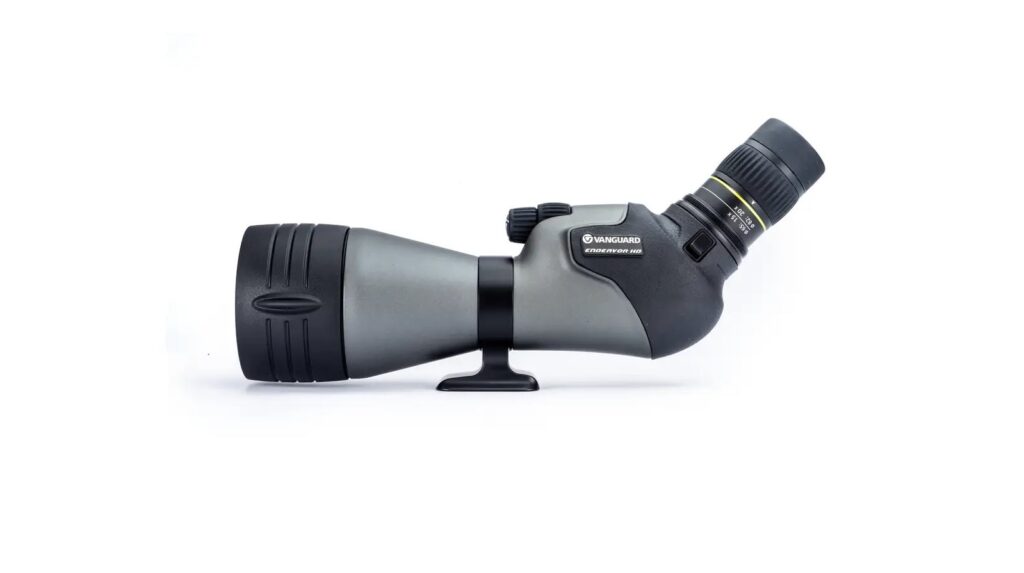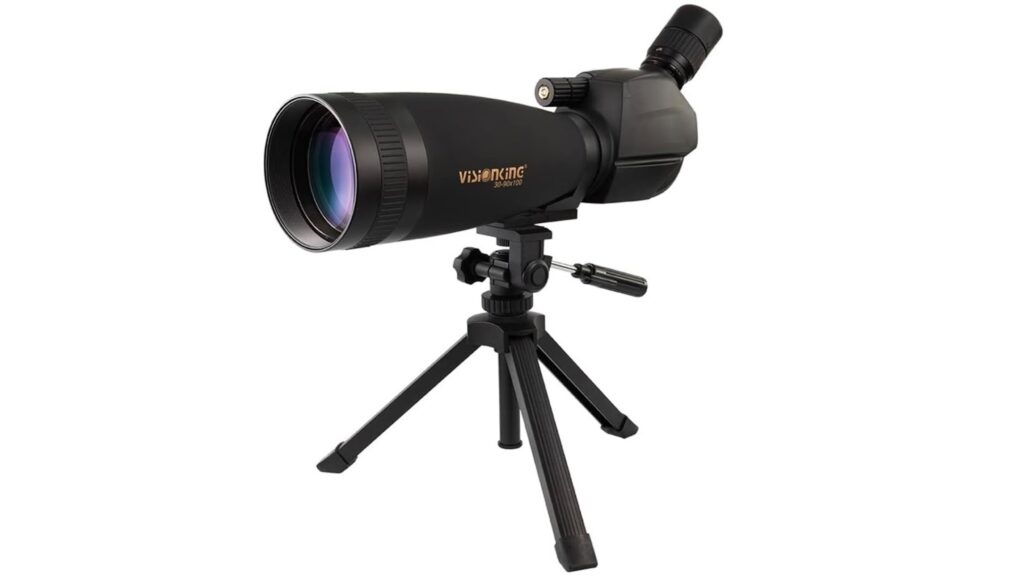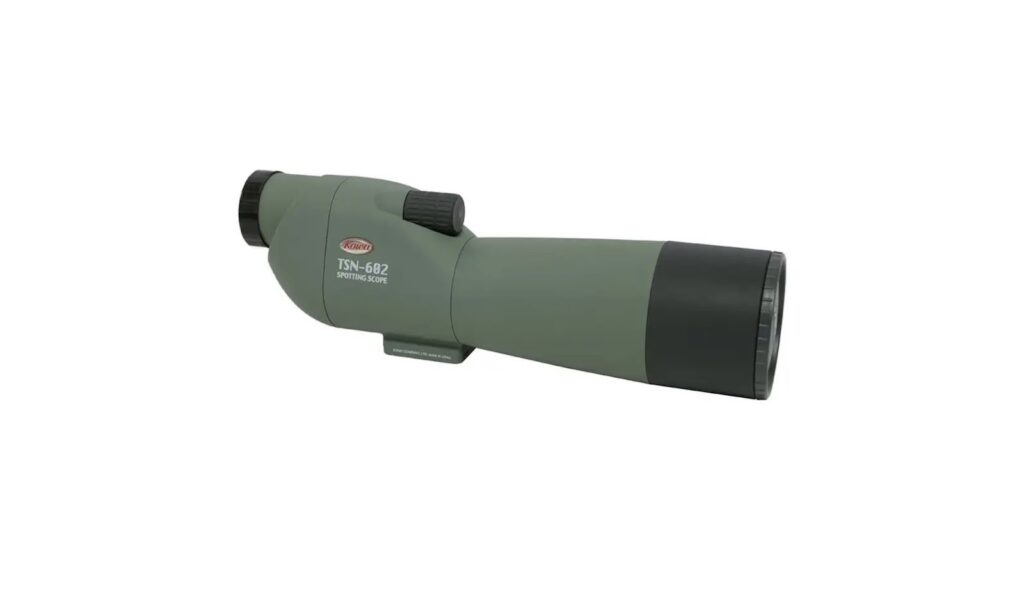When it comes to spotting scopes, some manufacturers excel while others fall short. Many top brands favored by hunters have had disappointing results in this price range, with mostly misses rather than hits.
As a result, compiling the top list of spotting scope under $500 price range was challenging. Therefore, we may include an option that slightly deviates from the usual criteria, but it will suffice.
Our selection process considered factors such as the quality of the glass, special coatings, and the ability to clearly view groupings within the 200-400 yard range. Let’s explore the options we have chosen.
The 6 Best Spotting Scopes Under $500
1. Leupold SX-2 Alpine 20-60×80 – Best Overall

The Leupold SX-2 Alpine 20-60×80 is a standout of mid-range spotting scopes. This versatile and high-performing optic boasts a host of features that make it a top contender in the sub-$500 category.
Specifications:
- Manufacturer: Leupold;
- Color: Shadow Gray, Black/Gray;
- Magnification: 20 – 60 x;
- Exit Pupil: 1 – 3 mm;
- Optical Coating: Guard-Ion;
- Scope Body Type: Angled;
- Lens Material: HD;
- Close Focus: 60 ft;
- Weather Resistance: Fog Resistant;
- Water Resistance Level: Waterproof;
- Finish: Matte.
Pros:
- HD Optics;
- Oversized eyepiece;
- Rugged construction;
- Fog/waterproof;
- Lifetime guarantee.
Cons:
- ED glass confusion.
The SX2 Alpine features Leupold’s Advanced Optical System with HD quality, although it does not specifically mention ED elements. The glass used is similar to ED glass as it is made with calcium fluoride, which helps reduce the dispersion of light waves at the objective lens. This means that while there may be some chromatic aberration, it might only be noticeable at higher magnifications and in challenging lighting conditions that many spotting scopes struggle with.
The oversized 59-94mm eyepiece and 19-18mm eye relief of the Alpine HD help reduce fatigue and compensate for less than perfect eye alignment, allowing you to spend longer periods behind the eyepiece. This makes it ideal for all-day glassing, big game hunts, and long-range spotting of groupings.
The build quality of the Alpine HD is impressive, with a well-balanced speed-to-precision helical focus, a fog-proof and waterproof body, and tested performance in extreme climate conditions ranging from 40 to 160 degrees Fahrenheit.
Given its name, the Alpine HD is likely designed for hunting in challenging environments where it can be put to the test. High mountain hunts for black bears, whitetails, mules, elk, and bighorn sheep are more successful when using a spotting scope that can withstand harsh alpine conditions.
2. Athlon Argos HD 20-60×85 – Best Value

The Athlon Argos HD 20-60×85 is a remarkable spotting scope that offers exceptional value for money in the sub-$500 category. With its impressive array of features and performance, this optic stands out as a clear contender for the best value in the market.
Specifications:
- Manufacturer: Athlon Optics;
- Color: Grey/Black;
- Magnification: 20 – 60x;
- Objective Lens Diameter: 85 mm;
- Eye Relief: 0.77 – 0.7 in;
- Exit Pupil: 4.2 – 1.42 mm;
- Field of View, Linear: 48 – 102 ft at 100 yds;
- Optical Coating: Wind Band Fully Multi-Coated;
- ED Glass: No;
- Lens Material: BAK4;
- Zoom: Yes;
- Close Focus: 39.4 ft;
- Weather Resistance: Yes;
- Water Resistance Level: Waterproof;
- Length: 16.9 in;
- Weight: 68.9 oz;
- Fabric/Material: 6061 Aluminum;
- Width: 4 in.
Pros:
- 85mm aperture;
- Advanced FMC coatings;
- Helical focus;
- Fog/waterproof;
- Extendable sunshade.
Cons:
- Optical quality vs marketing.
Being straightforward about the optical quality of the Argos HD may seem harsh, but the marketing suggests it has features that it actually lacks. It does not have features like ED glass or additional elements known for high-definition optics. Athlon claims it has “phase coated Porro prisms,” but Porro prisms are not affected by beam splitting like roof prisms.
In essence, Porro prisms excel in maintaining contrast and resolution, outperforming roof prisms without PC coatings. Despite the supposed PC coatings, the Argos performs well for its price range. It struggles with light loss beyond 40x magnification and off-axis sharpness, common issues in spotting scopes at similar price points.
Looking beyond the marketing hype, the Argos offers commendable resolution in low-light conditions, suitable for activities like hunting, range shooting, wildlife observation, and amateur lunar observation.
The adjustable features such as the magnification ring, multiposition eyecup, and extendable sunshade provide smooth operation. The focus knob can be sensitive at maximum power, which may not be ideal for quick birdwatching moments. However, for focusing during long-range observations in the field or at the shooting range, the sensitivity can be beneficial.
3. Vortex Diamondback HD 20-60×85 – Best for Hunting

The Vortex Diamondback HD 20-60×85 is a top-performing spotting scope that excels in the field, particularly for hunting applications. This versatile optic combines high-quality optics, durable construction, and user-friendly features, making it a prime choice for the best spotting scope under $500 for hunters.
Specifications:
- Manufacturer: Vortex;
- Magnification: 20 – 60 x;
- Objective Lens Diameter: 85 mm;
- Eye Relief: 18.3 – 20.3 mm;
- Exit Pupil: 1.41 – 4.25 mm;
- Field of View, Linear: 60 – 108 ft at 1000 yds;
- Field of View, Angle: 1.1 – 2.1 degrees;
- Optical Coating: Fully Multi-Coated;
- Close Focus: 24.6 ft;
- Weather Resistance: Fog Resistant;
- Water Resistance Level: Waterproof;
- Length: 16 in;
- Weight: 61.3 oz;
- Finish: Matte.
Pros:
- ArmorTek coating;
- Dual focus;
- Long eye relief;
- Argon gas;
- Arca-Swiss compatible.
Cons:
- Chromatic aberration.
The Diamondback HD spotting scopes feature an HD Optical System, but Vortex did not mention any ED elements. This can lead to color fringing which may be distracting for activities like birdwatching and lunar observation digiscoping.
While the optics of the Diamondback HD may not compare to the Viper HD or Razor HD, it is a suitable entry-level spotting scope for wildlife observation, range use up to 1000 yards, and Western deer hunting.
The Diamondback HD is rubber armored, waterproof, and filled with Argon gas, typically found in higher-end models. It offers long eye relief of 20-31.83mm, an adjustable eyecup and sunshade, and a rotating tripod ring.
A notable feature is the dual focus system for both coarse and fine adjustments using the helical focus collar. It is compatible with Arca-Swiss tripods without requiring additional plates and can be mounted on standard ¼-20 tripods.
The HD models of the Diamondback have increased weight and larger objectives. Weighing 60.9oz, this extra weight can help stabilize the setup, particularly in windy conditions often found in high mountainous regions and expansive landscapes.
4. Vanguard Endeavor HD 82 Scope

The Vanguard Endeavor HD 82 Scope is a noteworthy contender in the sub-$500 spotting scope market. This versatile and well-designed optic offers a compelling combination of optical performance, durability, and value.
Specifications:
- Manufacturer: Vanguard;
- Magnification: 20 – 60 x;
- Objective Lens Diameter: 82 mm;
- Eye Relief: 20 mm, 19 mm;
- Field of View, Linear: 17.4 – 36.7 m at 1000 m;
- Field of View, Angle: 2.1 degrees;
- ED Glass: Yes;
- Scope Body Type: Angled;
- Lens Material: Glass;
- Zoom: Yes;
- Close Focus: 19.7 ft;
- Weather Resistance: Shock Resistant;
- Water Resistance Level: Waterproof;
- Length: 380 mm;
- Weight: 63.8 oz;
- Included Accessories: Standard;
- Fabric/Material: Rubber, Magnesium Alloy;
- Magnification Type: Variable;
- Fogproof: Yes.
We mentioned before that we would slightly adjust the rules, and here is where we demonstrate how. The Vanguard Endeavor is priced just above $500, but during sales, you can purchase it within this price range. We made some adjustments to ensure we only offer you the most reliable and high-performing spotting scopes available. It’s not worth recommending a poor-quality product.
The Endeavor features a large objective lens that delivers exceptional brightness and light gathering capabilities. To fully utilize the 82mm lens, it is constructed with extra-low dispersion glass elements, fully multicoated, and equipped with BaK4 prism glass. There is more information to share about the Vanguard Endeavor, so stay tuned for the complete review.
5. Visionking 30-90X100SS Spotting Scope

The Visionking 30-90X100SS Spotting Scope is a unique and high-powered option in the sub-$500 market. With its impressive magnification range and large objective lens, this spotting scope offers a distinct set of capabilities that set it apart from its competitors.
Specifications:
- Large 100mm Full Multi-Coated objective lense for bright, clear images;
- 2-speed dual focus controls;
- RainGuard HD water-repellent lens coating;
- O-ring sealed, 100% waterproof;
- Dry Nnitrogen-Purged and Sealed, 100% fogproof;
- Large eye lens, long eye relief;
- Fully multi-coated optics;
- Close focusing;
- 30x-90x Zoom eyepiece;
- Retractable sunshade;
- Twist-up eyecups;
- BaK-4 prisms;
- Can be fitted to any standard camera tripod.
Pros:
- Price;
- Extreme high magnification;
- Huge aperture;
- Dual focus;
- Weatherproof.
Cons:
- Heavy.
If you believe you can handle these spotting scope specifications without some serious weight, you’re mistaken. Weighing almost 6 pounds, this optic is quite heavy and requires a sturdy tripod to support it.
The purpose of such extreme specifications is to provide enhanced visibility. The 100mm aperture allows maximum ambient light intake for activities like bird watching, wildlife observation, or stargazing. The high magnification necessitates using the 2-speed dual focus dials for the clearest image.
While the BaK4 prism glass is fully multicoated, there is no mention of phase-prism coatings or extra-low dispersion glass elements. This absence of additional glass features is unexpected for a high-powered scope and may impact clarity at maximum magnification.
Despite being a generic brand, this spotter excels in durability. It features RainGuard HD water-repellent lens coating (a familiar Bushnell technology), O-ring sealing, nitrogen purging, and is 100% waterproof.
For spotters who prefer setting up and remaining stationary, the Visionking scope is suitable. It comes with a tripod included in the purchase, saving you from immediately needing to buy one.
6. Kowa TSN-601 Angled 60mm Spotting Scope

The Kowa TSN-601 Angled 60mm Spotting Scope is a compact and lightweight option that excels in delivering high-quality optics within the sub-$500 price range. With its angled design and premium features, this spotting scope offers a balance of performance and portability.
Specifications:
- Item Package Dimensions L x W x H: 14.2 x 5.9 x 5 inches;
- Package Weight: 2.55 Pounds;
- Item Dimensions LxWxH: 11.8 inches;
- Item Weight: 2.5 Pounds;
- Brand Name: Kowa;
- Warranty Description: Limited Lifetime Warranty (Lifetime of Product);
- Color: Green;
- Number of Items: 1;
- Manufacturer: Kowa;
- Part Number: TSN-601;
- Style: Angled Body;
- Sport Type: Hunting.
Pros:
- Price;
- Interchangeable eyepiece system;
- Made in Japan;
- Weatherproof;
- 10-year warranty.
Cons:
- Scope body only.
What to Look for in a Spotting Scope in This Price Range
When shopping for a spotting scope under $500, there are several key factors to consider to ensure you get the best value for your money. By paying attention to the following aspects, you can make an informed decision and choose a spotting scope that meets your specific needs and preferences.
Glass & Coatings
One of the most critical components of a spotting scope is the quality of its glass and coatings. Look for spotting scopes that feature high-quality optical glass with special coatings like fully multi-coated or dielectric coatings. These coatings help improve light transmission, reduce glare, and enhance image clarity and contrast.
- Fully Multi-Coated Lenses: Ensure maximum light transmission for bright and clear images;
- Dielectric Coatings: Enhance reflectivity for improved low-light performance;
- ED (Extra-Low Dispersion) Glass: Minimize chromatic aberration for sharper images.
Magnification & Objective Lens (Configuration)
The magnification range and objective lens diameter play a crucial role in determining the spotting scope’s performance and versatility. Consider the typical viewing conditions and distances you will be observing to choose the right configuration for your needs.
- Magnification Range: Opt for a spotting scope with a wide magnification range for flexibility in different scenarios;
- Objective Lens Diameter: Larger objective lenses gather more light for brighter images, especially in low-light conditions.
Eye Relief & FOV
Comfortable eye relief and a generous field of view are essential for extended viewing sessions and quick target acquisition. Look for spotting scopes that offer adjustable eyecups and sufficient eye relief to accommodate users wearing glasses.
- Eye Relief: Aim for at least 14mm of eye relief for comfortable viewing, especially for eyeglass wearers;
- Field of View (FOV): A wider FOV allows you to scan larger areas and track moving targets more effectively.
Size & Weight
The size and weight of a spotting scope can significantly impact its portability and ease of use in the field. Consider your intended activities and how far you’ll need to carry the scope when choosing a model that strikes a balance between performance and convenience.
- Compact Design: Opt for a compact and lightweight spotting scope for easy transportation during outdoor adventures;
- Tripod Compatibility: Ensure the spotting scope is tripod adaptable for stable and shake-free observations.
Durability
Outdoor activities can expose spotting scopes to various elements and rough handling, so durability is a crucial factor to consider. Look for models that feature rugged construction, waterproof and fogproof properties, and protective coatings to withstand challenging conditions.
- Weather Resistance: Choose spotting scopes that are waterproof and fogproof for reliable performance in rain or humid environments;
- Durable Materials: Opt for scopes made from sturdy materials like magnesium alloy or polycarbonate for long-lasting durability.
By evaluating these key factors and prioritizing your specific requirements, you can select a spotting scope under $500 that aligns with your preferences and delivers the optical performance you need for your outdoor pursuits.
Final Thoughts
Spotting scopes under $500 offer a compelling balance of performance, features, and affordability for outdoor enthusiasts, birdwatchers, hunters, and target shooters. With a diverse range of options available in this price segment, finding the right spotting scope requires careful consideration of optical quality, durability, and user-friendly features.
When selecting a spotting scope in this price range, remember to assess key factors such as glass quality, magnification range, eye relief, size, weight, and durability to make an informed decision. By understanding what to look for and how different features contribute to overall performance, you can confidently choose a spotting scope that enhances your outdoor experiences and meets your observational requirements.
Overall, the top spotting scopes under $500 reviewed in this article represent excellent choices for outdoor enthusiasts who demand a reliable and high-quality optic. Whether you’re exploring nature, tracking wildlife, or honing your shooting skills, investing in a quality spotting scope can elevate your outdoor adventures and provide years of visual enjoyment and discovery.
